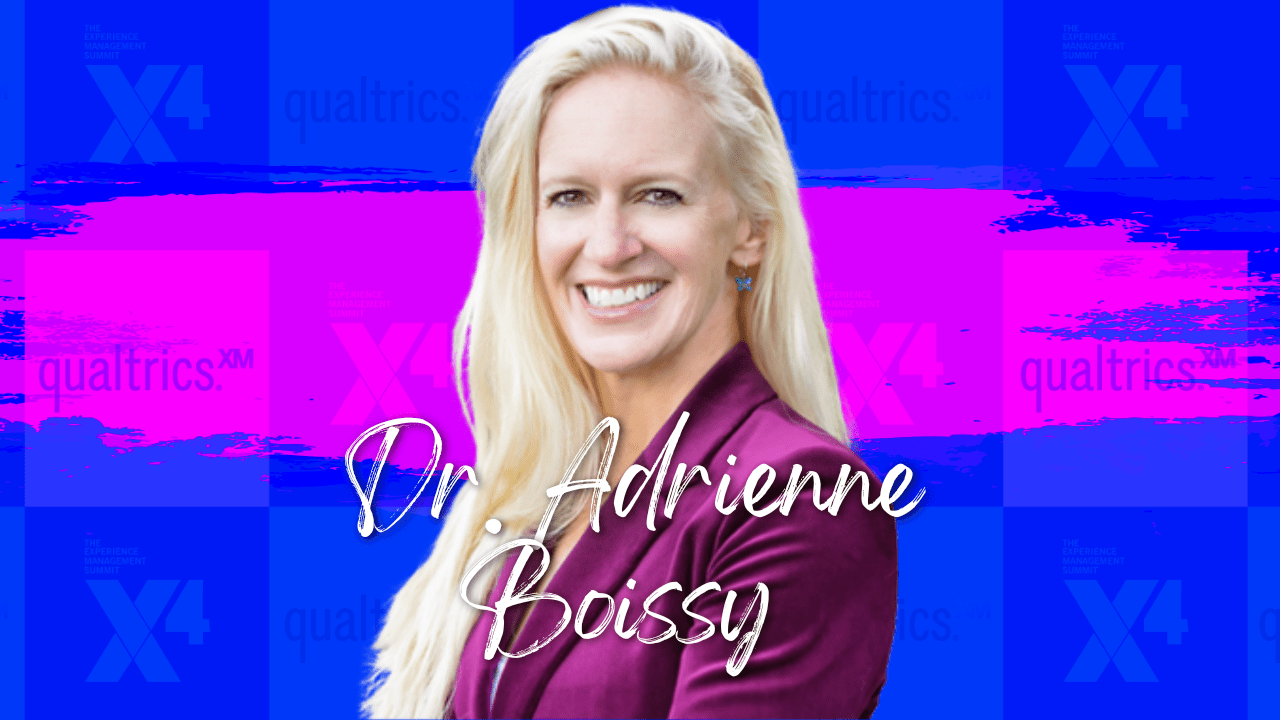Decoding the “X” Factor in Healthcare Industry: Qualtrics’ Dr. Adrienne Boissy Explains the Science Behind Experience Management (XM)

The XM platform is used by healthcare leaders to understand what people are saying about your organization, wherever they are saying it. The ultimate listening tool, XM easily surfaces insights, from the contact center to the web – and everywhere in between, to help you design experiences that improve satisfaction, loyalty, and trust. Find out how we work with Healthcare providers, Payers, and Life Sciences.
A healthcare industry pioneer, Adrienne envisions an integrated patient and employee experience in healthcare powered by empathy, technology, co-design, and evidence-based research. She publishes extensively on the future of experience design and metrics that matter in humane experiences of health. She is a practicing neurologist and the former Chief Experience Officer of the Cleveland Clinic.
Hello Dr. Adrienne, welcome to the AiThority Interview Series. Please tell us about your role at Qualtrics and how you arrived at the company.
I am the Chief Medical Officer at Qualtrics, which means I work with healthcare organizations to imagine and deliver exceptional experiences for their patients and employees. I have the privilege to innovate with executives and leaders every day to power cultures of empathy and person-centered care.
I am also a practicing staff neurologist at the Cleveland Clinic, where I previously held the role of Chief Experience Officer, and a Master’s trained ethicist.
Qualtrics has made rapid strides in experience management for healthcare companies. How did you establish the relationship between Quality, Safety, and Experience for healthcare professionals?
Fortunately, that was made for me.
Decades ago, the field of medicine put a stake in the ground that high-quality care was about safe and equitable care, and care that put the values, needs, and preferences of the patient at the center. In addition, there have been innumerable calls from respected institutions for the achievement of the Quadruple Aim, which focuses on better health of populations, lower costs, better experiences of care, and reduction of burnout. We know performance across these domains moves together and is also interdependent, so for me, my job is to really make sure our solutions make that as easy as possible to deliver on and strategize on the how.
![The Cost of Getting Customer Experiences Wrong is Skyrocketing in 2024]() According to a report, 6 out of 10 customers feel healthcare services are designed to be confusing. So, how does Qualtrics improve the CX for healthcare customers under your stewardship?
According to a report, 6 out of 10 customers feel healthcare services are designed to be confusing. So, how does Qualtrics improve the CX for healthcare customers under your stewardship?
Compared to some of the seamless, intuitive processes in the consumer world, I think there is some truth here, but I don’t believe it’s intentional. The reality is that healthcare delivery is a highly regulated, extraordinarily complex industry within a much larger ecosystem. Design is an important word here as the human-centered design processes that fuel some of the most frictionless experiences are slow to be adopted in healthcare.
And when we look at friction in healthcare, its access, billing, delays, and coordination of care. If someone can’t even get in the door, not only will they not receive the care they need, but their experience is horrible. That matters because it amplifies suffering. At Qualtrics, we propel some of the best organizations to proactively drive access, make digital designs work, generate growth, and get immediate follow-up on patient needs.
If empathy is about a deep understanding of the human condition, we use large language models to dig deep on emotions and intensity of that emotion, which drives their frontline employee engagement with data in real time and system-wide improvements for current – and future – patients.
What are the key differences between customer experience management (CXM) and patient experience management (PXM)? How do you create a balance for healthcare customers?
I believe one of the fundamental differences is about choice.
People don’t have a choice when they get sick or whether it is an emergency. They also have little to no transparency of the costs of the services. And, they are in a more vulnerable situation than what you might typically think of for CXM. Shopping for a new pair of sunglasses has much lower stakes than receiving a necessary treatment or having invasive procedures. So, we need to earn more trust when it comes to PXM versus CXM – and that comes from empathy and humans caring for other humans.
At the same time, the healthcare industry can learn from other industries that have mastered the fundamentals of customer service and service recovery, including making it all easier. If your favorite brand remembers your birthday, why shouldn’t your doctor’s office? Small touches like this can help build that connection.
AI is a game-changer across the healthcare industry. As a CX leader, what are your AI goals for the period between 2024 and 2030?
There is so much potential for what AI can bring to healthcare. Many IT leaders are focused on improving clinical efficiency and ambient listening, which is key.
What I’m focused on in the near term is how it can transform the pebbles (or boulders) in the shoe to bubbles of joy. The very real, day-to-day pain points, like websites that dead end, will become seamless and omnichannel access. Fragmented data will become connected and more meaningful.
But I want to dig deeper into our understanding of humans. Not feeling seen or known is a significant driver for the disengagement of patients and employees, and the costs are rising. I am fired up about predictive capabilities around experiences, immediate insights followed with personalized interventions, and a remembrance of identity and preferences that change how we make people feel.
We all know trust is fragile. As we face a future wherein we all have digital identities, I want to be a part of defining thoughtful and ethical approaches to managing data security, consent, and equity. That is only done by designing with all the stakeholders we have and by prioritizing the same safety, quality, and experience principles we aspire to for our physical selves.
Thank you, Dr. Adrienne! That was fun and we hope to see you back on AiThority.com’s Tech Bytes soon.
AiThority.com will be at the upcoming X4: The Experience Management Summit from May 1-3 in Salt Lake City, where our AI reporters will share much more about the new Qualtrics AI-powered suites and business cases across different industries.
Stay tuned for more updates!
[To share your insights with us as part of the editorial and sponsored content packages, please write to sghosh@martechseries.com]
Dr. Adrienne Boissy is the Chief Medical Officer of Qualtrics. She is responsible for shaping the patient and employee experience in the healthcare industry, including technology design, research, consulting, and innovation in experience management. Prior to joining Qualtrics, she served as the Chief Experience Officer of the Cleveland Clinic Health System and staff neurologist at the Cleveland Clinic Mellen Center for Multiple Sclerosis. During her tenure at Cleveland Clinic, Dr. Boissy led strategic, international initiatives to improve every aspect of a patient’s encounter with healthcare – from their physical comfort to their educational, financial, emotional and spiritual needs. She created evidence-based relationship-centered communication skills training, which serves as a global standard for healthcare, and revolutionized the conversation on patient experience measurement.
Dr. Boissy previously co-chaired the Empathy and Innovation Summit, the largest independent summit on patient experience in the world. She also serves as Editor Emeritus of the Journal of Patient Experience and on the advisory boards for Option B and HIMSS Media.
Dr. Boissy earned her Doctor of Medicine from the Penn State College of Medicine and Bachelor’s degree from Boston University. She completed a Master’s degree in Bioethics from Case Western Reserve University and trained in advanced design thinking from IDEO.
Qualtrics helps healthcare and life sciences organizations design experiences that improve satisfaction, loyalty and trust. Qualtrics helps organizations deliver a seamless and compassionate healthcare experience by optimizing the moments that matter most to patients, employees and communities. Qualtrics delivers the most comprehensive platform for strategic experience management, helping healthcare organizations listen to patients and employees on their terms, uncover what matters most and act quickly to create meaningful impact. In doing so, experience data can be paired with quality, operational and financial data to articulate real value. The AI-powered solutions help leaders understand the key drivers of patient and employee behavior, predict what they want and automate actions that make it faster, easier and more efficient to personalize experiences at scale. Qualtrics is a CMS-approved vendor for all required CAHPS programs, and a HITRUST-certified and FEDRAMP-compliant experience management platform, so organizations can confidently collect and analyze data knowing sensitive information is secure.
To learn more, please visit qualtrics.com/healthcare.
- About Qualtrics
Qualtrics, the leader and creator of the experience management category, is a cloud-native software platform that empowers organizations to deliver exceptional experiences and build deep relationships with their customers and employees. With insights from Qualtrics, organizations can identify and resolve the greatest friction points in their business, retain and engage top talent, and bring the right products and services to market. Nearly 20,000 organizations around the world use Qualtrics’ advanced AI to listen, understand, and take action. Qualtrics uses its vast universe of experience data to form the largest database of human sentiment in the world. Qualtrics is co-headquartered in Provo, Utah and Seattle. To learn more, please visit qualtrics.com.


Comments are closed.